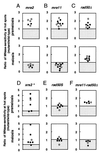Mutations in the MRE11, RAD50, XRS2, and MRE2 genes alter chromatin configuration at meiotic DNA double-stranded break sites in premeiotic and meiotic cells
- PMID: 9435246
- PMCID: PMC18474
- DOI: 10.1073/pnas.95.2.646
Mutations in the MRE11, RAD50, XRS2, and MRE2 genes alter chromatin configuration at meiotic DNA double-stranded break sites in premeiotic and meiotic cells
Abstract
In the yeast Saccharomyces cerevisiae, meiotic recombination is initiated by DNA double-stranded breaks (DSBs) occurring in micrococcal nuclease (MNase)-hypersensitive regions of the chromatin. MNase-sensitive sites also undergo meiosis-specific alterations in chromatin structure prior to the appearance of DSBs. DSB formation requires the products of numerous genes. Herein we have examined the effects of mutations in four such genes, MRE11, RAD50, XRS2, and MRE2, on MNase sensitivity at DSB sites in premeiotic and meiotic cells. Disruption mutations in each of four genes confer greater than wild-type levels of MNase sensitivity in premeiotic cells. In meiotic prophase, all of these mutations affect MNase sensitivity at DSB sites and fall into two distinct phenotypic classes. The type 1 mutations (mre2 and mre11) confer a reduction in MNase sensitivity relative to the wild-type level. The type 2 mutations (rad50 and xrs2) permit a meiotic increase in the MNase sensitivity to reach a final level higher than that observed in wild-type cells. An mre11 disruption mutation (type 1) is epistatic to a rad50 null mutation (type 2) with respect to its meiotic effects on MNase sensitivity, suggesting that the events observed in the type 2 mutants during meiosis are dependent upon type 1 functions. One interpretation of these results is that Mre11, Rad50, Xrs2, and possibly Mer2 (whose splicing is Mre2-dependent) form a complex at recombination hot spots and establish a chromatin/DNA configuration favorable for the induction of DSBs.
Figures



Similar articles
-
Functions of the yeast meiotic recombination genes, MRE11 and MRE2.Adv Biophys. 1995;31:67-76. doi: 10.1016/0065-227x(95)99383-z. Adv Biophys. 1995. PMID: 7625279 Review.
-
Distinct roles of two separable in vitro activities of yeast Mre11 in mitotic and meiotic recombination.EMBO J. 1998 Nov 2;17(21):6412-25. doi: 10.1093/emboj/17.21.6412. EMBO J. 1998. PMID: 9799249 Free PMC article.
-
Interaction of Mre11 and Rad50: two proteins required for DNA repair and meiosis-specific double-strand break formation in Saccharomyces cerevisiae.Genetics. 1995 Apr;139(4):1521-32. doi: 10.1093/genetics/139.4.1521. Genetics. 1995. PMID: 7789757 Free PMC article.
-
Formation of the yeast Mre11-Rad50-Xrs2 complex is correlated with DNA repair and telomere maintenance.Nucleic Acids Res. 1999 May 15;27(10):2072-9. doi: 10.1093/nar/27.10.2072. Nucleic Acids Res. 1999. PMID: 10219078 Free PMC article.
-
The multiple roles of the Mre11 complex for meiotic recombination.Chromosome Res. 2007;15(5):551-63. doi: 10.1007/s10577-007-1147-9. Chromosome Res. 2007. PMID: 17674145 Review.
Cited by
-
Use of a recombination reporter insert to define meiotic recombination domains on chromosome III of Saccharomyces cerevisiae.Mol Cell Biol. 1999 Jul;19(7):4832-42. doi: 10.1128/MCB.19.7.4832. Mol Cell Biol. 1999. PMID: 10373533 Free PMC article.
-
Cohesin relocation from sites of chromosomal loading to places of convergent transcription.Nature. 2004 Jul 29;430(6999):573-8. doi: 10.1038/nature02742. Epub 2004 Jun 30. Nature. 2004. PMID: 15229615 Free PMC article.
-
The Nijmegen breakage syndrome gene and its role in genome stability.Chromosoma. 2004 Sep;113(2):53-61. doi: 10.1007/s00412-004-0298-0. Epub 2004 Jul 17. Chromosoma. 2004. PMID: 15258809 Review.
-
Role of RAD52 epistasis group genes in homologous recombination and double-strand break repair.Microbiol Mol Biol Rev. 2002 Dec;66(4):630-70, table of contents. doi: 10.1128/MMBR.66.4.630-670.2002. Microbiol Mol Biol Rev. 2002. PMID: 12456786 Free PMC article. Review.
-
Interactions between Mei4, Rec114, and other proteins required for meiotic DNA double-strand break formation in Saccharomyces cerevisiae.Chromosoma. 2007 Oct;116(5):471-86. doi: 10.1007/s00412-007-0111-y. Epub 2007 Jun 9. Chromosoma. 2007. PMID: 17558514 Free PMC article.
References
-
- Nicolas A, Treco D, Schultes N P, Szostak J W. Nature (London) 1989;338:35–39. - PubMed
-
- Sun H, Treco D, Schultes N P, Szostak J W. Nature (London) 1989;338:87–90. - PubMed
-
- Cao L, Alani E, Kleckner N. Cell. 1990;61:1089–1101. - PubMed
-
- White M A, Detloff P, Strand M, Petes T D. Curr Genet. 1992;21:109–116. - PubMed
Publication types
MeSH terms
Substances
LinkOut - more resources
Full Text Sources
Molecular Biology Databases
Research Materials
Miscellaneous

